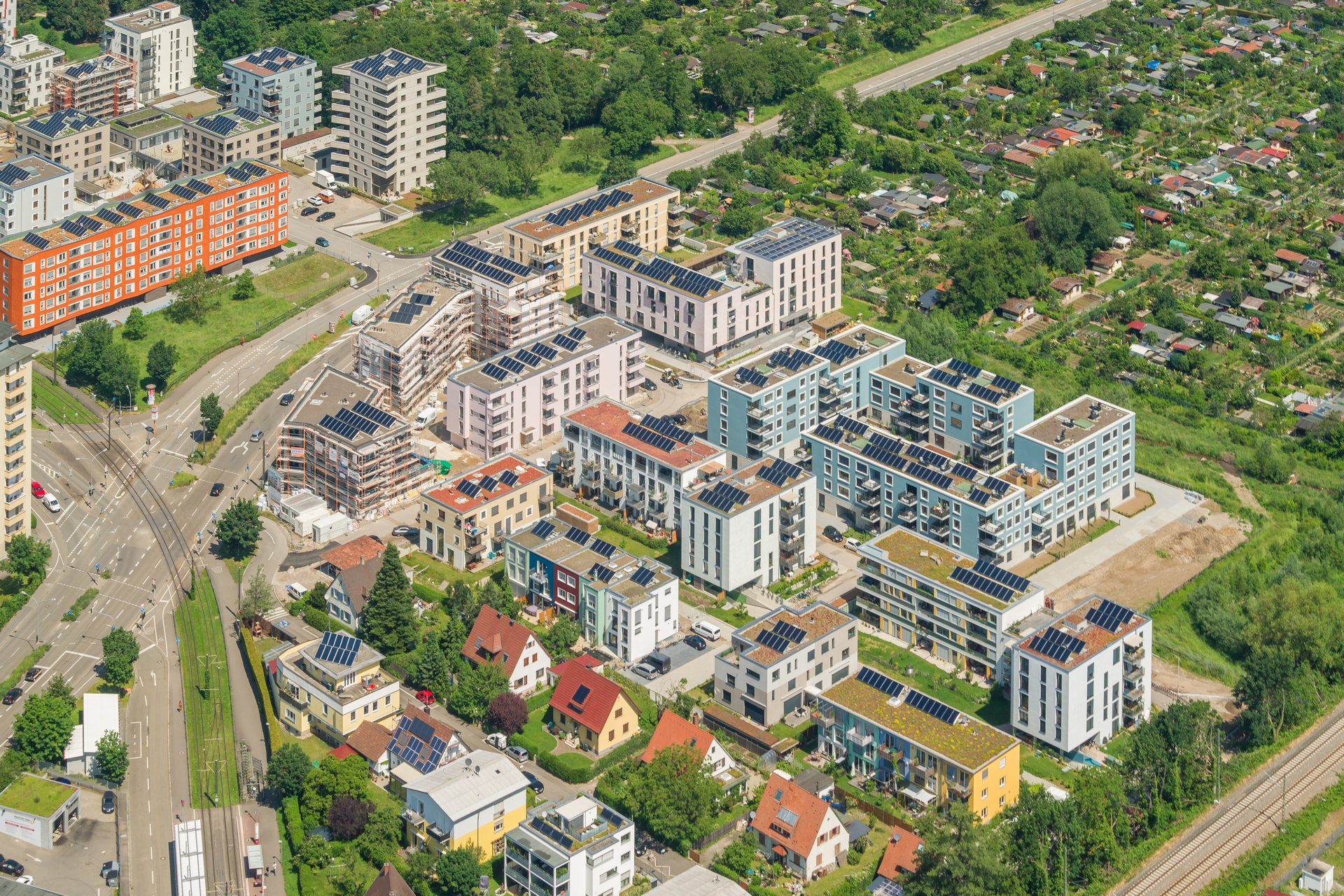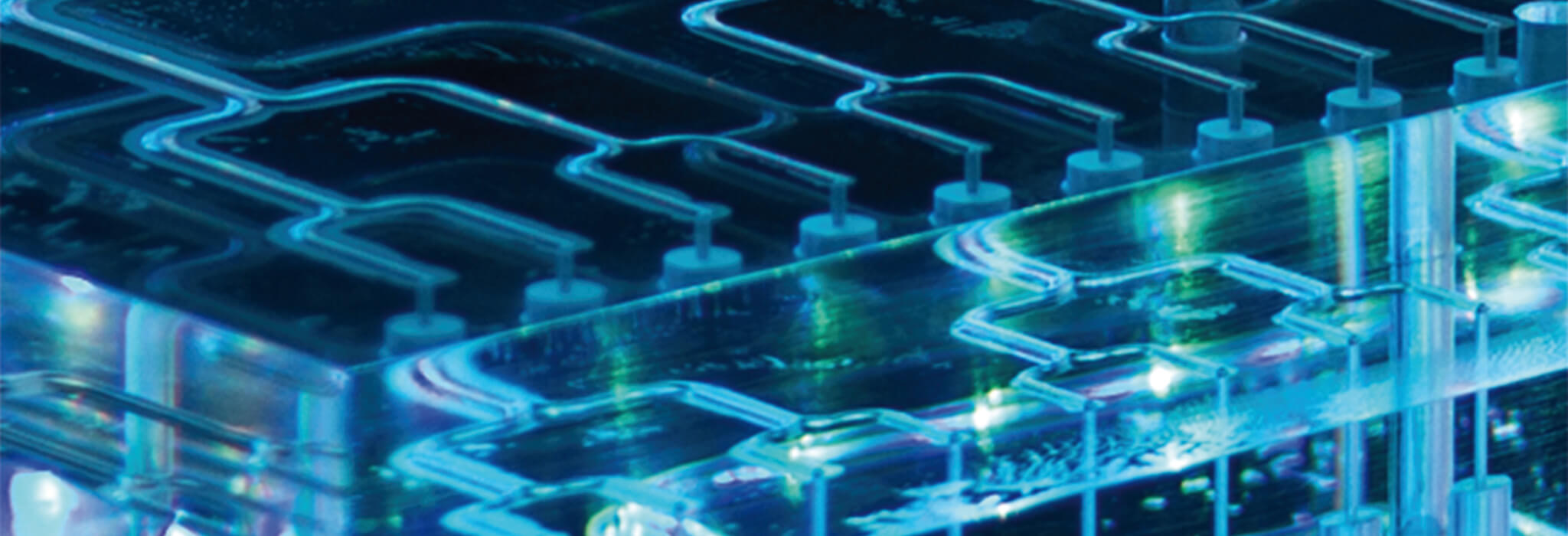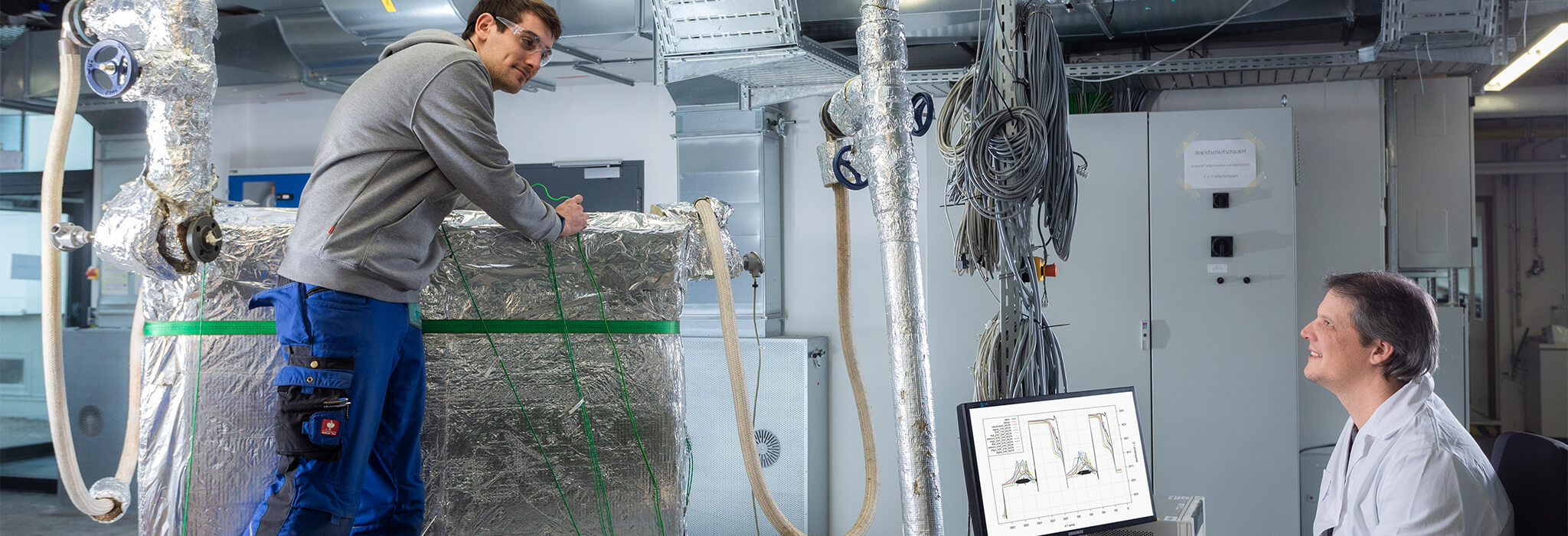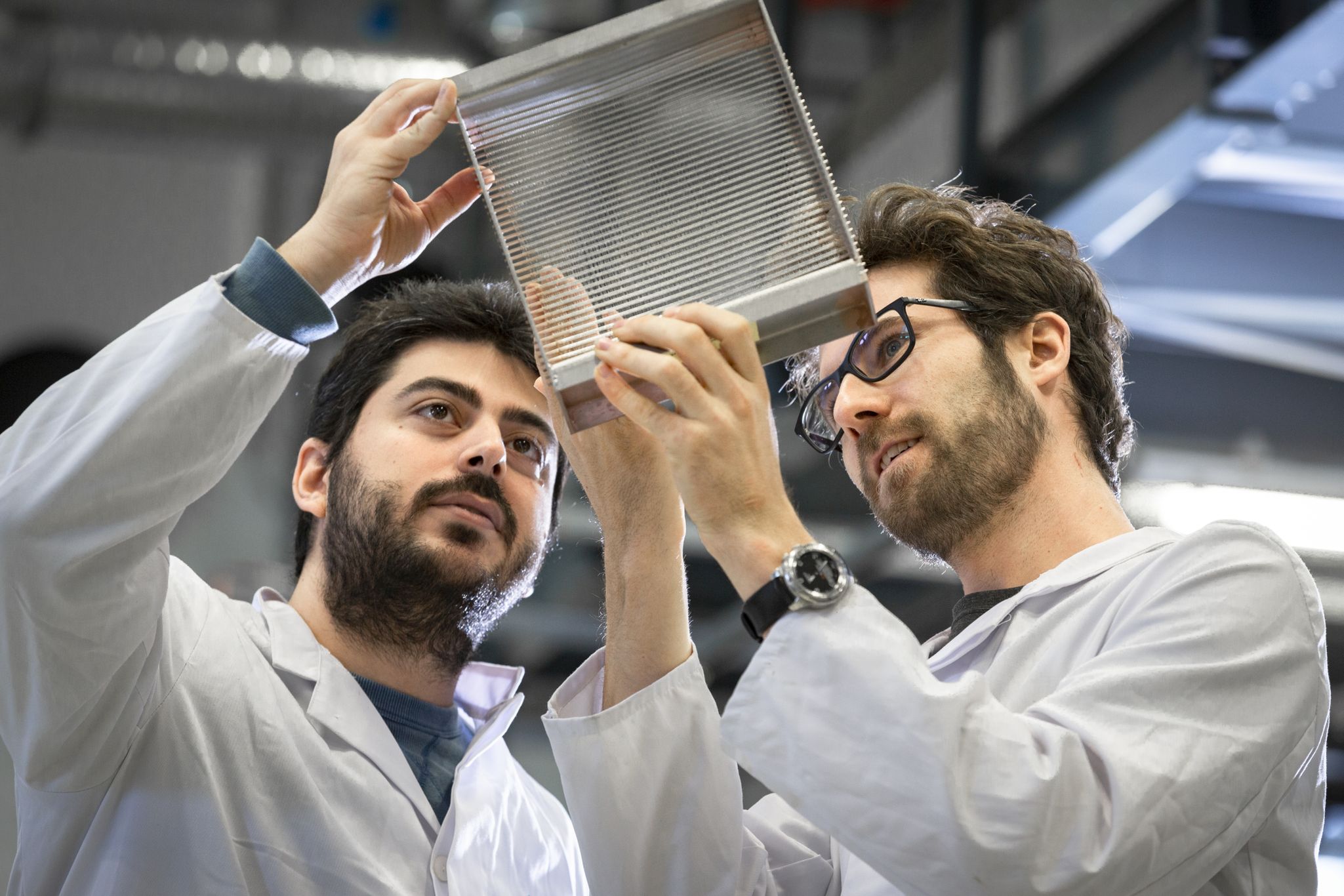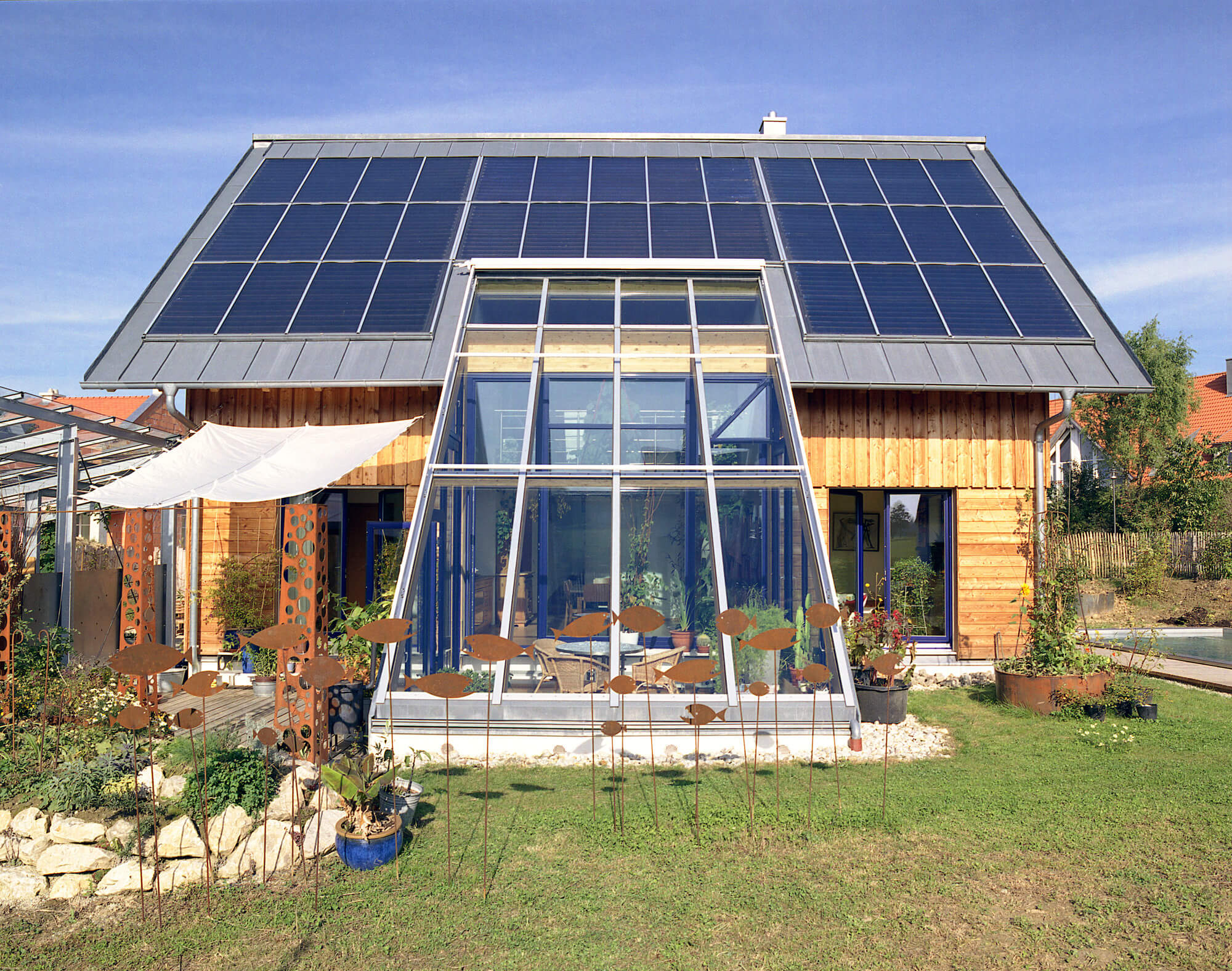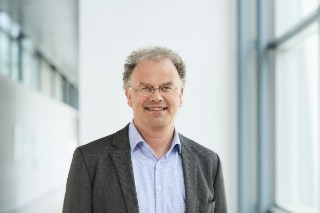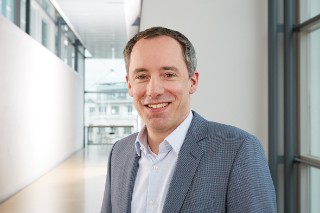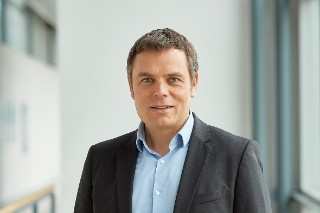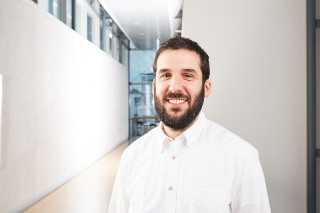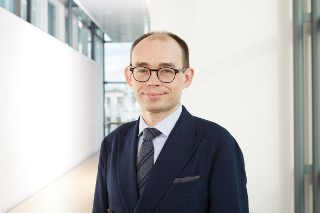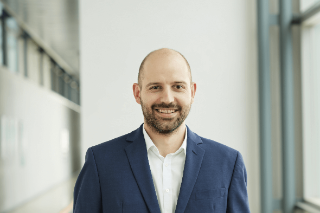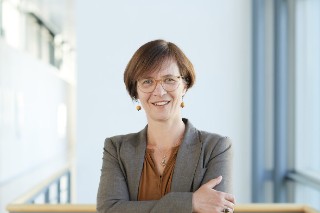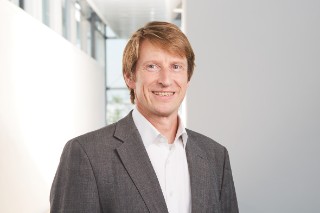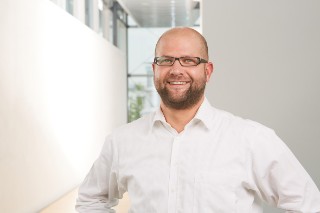Jahr
Year | Titel/Autor:in
Title/Author | Publikationstyp
Publication Type |
|---|
| 2025 |
A product data network to enable faster, easier, and better planning of building envelopes
Maurer, Christoph; Wacker, Simon; Bueno Unzeta, Bruno; Jonsson, Jacob C.; Lamy, Hervé; Bush, David; Shi, Meiling; Sprenger, Wendelin; Mitchell, Robin D.; Wilson, Helen Rose; Curcija, Dragan Charlie; Kuhn, Tilmann |
Zeitschriftenaufsatz
Journal Article
|
| 2024 |
Analysis of the Performance and Operation of a Photovoltaic-Battery Heat Pump System Based on Field Measurement Data
Baraskar, Shubham Vijay; Günther, Danny; Wapler, Jeannette; Lämmle, Manuel |
Zeitschriftenaufsatz
Journal Article
|
| 2024 |
When Polymorphism in Metal-Organic Frameworks Enables Water Sorption Profile Tunability for Enhancing Heat Allocation and Water Harvesting Performance
Matemb Ma Ntep, Tobie J.; Wahiduzzaman, Mohammad; Laurenz, Eric; Cornu, Ieuan; Mouchaham, Georges; Dovgaliuk, Iurii; Nandi, Shyamapada; Knop, Klaus; Jansen, Christian; Nouar, Farid; Florian, Pierre; Füldner, Gerrit; Maurin, Guillaume; Janiak, Christoph; Serre, Christian |
Zeitschriftenaufsatz
Journal Article
|
| 2023 |
Ökobilanzierung: mehr als der CO2-Fussabdruck
Fischer, Marie |
Zeitschriftenaufsatz
Journal Article
|
| 2023 |
A facile spray-pressing synthesis approach for reusable photothermal masks
Lu, Yi; Liu, Yi-Xuan; Wang, Yong; Oestreich, Robert; Xu, Zi-Yan; Zhang, Wen; Hügenell, Philipp P.C.; Janiak, Christoph; Yang, Xiao-Yu |
Zeitschriftenaufsatz
Journal Article
|
| 2023 |
Detailed Thermal Evaluation of Brazed Plate Heat Exchanger Using Infrared Thermography
Will, Torsten; Schnabel, Lena; Köhler, Jürgen |
Zeitschriftenaufsatz
Journal Article
|
| 2023 |
Zyklische Wasserverdampfer für Adsorptionskälteanlage. Herausforderungen eines vereisenden Betriebs, Teil 1
Volmer, Rahel; Nonnen, Thomas; Da Silva Moreira, Adrian; Füldner, Gerrit; Schnabel, Lena; Herrmann, Ralph |
Zeitschriftenaufsatz
Journal Article
|
| 2023 |
Wärmepumpen für bestehende Mehrfamilienhäuser marktreif machen: Messungen in realen Gebäuden zeigen gute Performance
Metz, Jakob; Bongs, Constanze; Günther, Danny; Wapler, Jeannette; Lämmle, Manuel |
Zeitschriftenaufsatz
Journal Article
|
| 2023 |
Entwicklung von meteorologischen Datensätzen zur Verwendung in Berechnungsverfahren für die thermische Beanspruchung von Glas und Glas-PV-Modulen (BIPV) im Bauwesen - Ein Bericht aus der Forschungspraxis
Ensslen, Frank; Herzberg, Wiebke |
Zeitschriftenaufsatz
Journal Article
|
| 2023 |
Wärmeversorgung im Geschosswohnungsbau mit Wärmepumpen
Bongs, Constanze; Wapler, Jeannette; Metz, Jakob; Miara, Marek; Lämmle, Manuel |
Zeitschriftenaufsatz
Journal Article
|
| 2023 |
Der digitale Gebäudezwilling. Wie kann er zur energetischen Optimierung von Gebäuden beitragen?
Frison, Lilli; Réhault, Nicolas |
Zeitschriftenaufsatz
Journal Article
|
| 2023 |
Monolithic Zirconium-based Metal-Organic Frameworks for Energy-Efficient Water Sorption Applications
Çamur, Ceren; Babu, Robin; Suárez del Pino, José A.; Rampal, Nakul; Pérez-Carvajal, Javier; Hügenell, Philipp; Ernst, Sebastian-Johannes; Silvestre-Albero, Joaquin; Imaz, Inhar; Madden, David G.; Maspoch, Daniel; Fairen-Jimenez, David |
Zeitschriftenaufsatz
Journal Article
|
| 2023 |
Niedrigere Trinkwarmwasser-Systemtemperaturen bringen Wärmepumpen in die Breite
Kropp, Michael; Lämmle, Manuel; Schauer, Christian; Reiter, Fabian |
Zeitschriftenaufsatz
Journal Article
|
| 2023 |
Refrigerant charge distribution in brine-to-water heat pump using R290 as refrigerant
Sánchez-Moreno-Giner, Luis; Methler, Timo; Barceló-Ruescas, Francisco; Gonzalvez-Maciá, José |
Zeitschriftenaufsatz
Journal Article
|
| 2023 |
Numerical Modelling and Evaluation of a Novel Sorption Module for Thermally Driven Heat Pumps and Chillers using Open-Source Simulation Library
Velte-Schäfer, Andreas; Zhang, Yannan; Nonnen, Thomas; Wittstadt, Ursula; Frazzica, Andrea; Füldner, Gerrit; Palomba, Valeria |
Zeitschriftenaufsatz
Journal Article
|
| 2023 |
Solare Kühlung und Trocknung von Fischen in Kenia
Fischer, Matthias; Esper, Albert; Pfanner, Norbert; Morgenstern, Alexander |
Zeitschriftenaufsatz
Journal Article
|
| 2023 |
Comparison of PVT - heat pump systems with reference systems for the energy supply of a single-family house
Chhugani, Bharat; Pärisch, Peter; Helmling, Sebastian; Giovannetti, Federico |
Zeitschriftenaufsatz
Journal Article
|
| 2023 |
Transfer learning methodology for machine learning based fault detection and diagnostics applied to building services
Réhault, Nicolas; Rist, Tim; Chavan, Kunal |
Zeitschriftenaufsatz
Journal Article
|
| 2023 |
Photovoltaic-Thermal Technology - PVT Collectors, Systems and Applications
Kramer, Korbinian; Mehnert, Stefan; Munz, Gunther; Helmling, Sebastian; Lämmle, Manuel |
Zeitschriftenaufsatz
Journal Article
|
| 2023 |
Modeling of thin-film interference filters on structured substrates: Microfacet-based BSDF versus ray tracing
Wessels, Andreas; Christen, Leonard; Callies, Adrian; Kroyer, Thomas; Höhn, Oliver; Bläsi, Benedikt |
Zeitschriftenaufsatz
Journal Article
|
| 2023 |
Heat Pump Systems in Existing Multifamily Buildings: A Meta-Analysis of Field Measurement Data Focusing on the Relationship of Temperature and Performance of Heat Pump Systems
Lämmle, Manuel; Kropp, Michael; Metz, Jakob; Wapler, Jeannette; Oltersdorf, Thore; Günther, Danny; Herkel, Sebastian; Bongs, Constanze |
Zeitschriftenaufsatz
Journal Article
|
| 2023 |
Vergleich verschiedener Simulationswerkzeuge am Beispiel einer füllmengenreduzierten Propanwärmepumpe
Beckschulte, Moritz; Will, Torsten; Koura, Adel Mohamed Nabil Ibrahim; Dankwerth, Clemens; Methler, Timo; Morawietz, Katharina; Schnabel, Lena |
Zeitschriftenaufsatz
Journal Article
|
| 2023 |
Basic Adsorption Heat Exchanger Theory for Performance Prediction of Adsorption Heat Pumps
Velte-Schäfer, Andreas; Laurenz, Eric; Füldner, Gerrit |
Zeitschriftenaufsatz
Journal Article
|
| 2023 |
Zyklische Wasserverdampfer für Adsorptionskälteanlagen. Herausforderungen eines vereisenden Betriebs, Teil 2
Volmer, Rahel; Nonnen, Thomas; Da Silva Moreira, Adrian; Füldner, Gerrit; Schnabel, Lena; Herrmann, Ralph |
Zeitschriftenaufsatz
Journal Article
|
| 2023 |
Optimization of energetic refurbishment roadmaps for multi-family buildings utilizing heat pumps
Vollmer, Raphael; Lämmle, Manuel; Hess, Stefan; Henning, Hans-Martin |
Zeitschriftenaufsatz
Journal Article
|
| 2023 |
Producing the goods
Morgenstern, Alexander; Pfanner, Norbert |
Zeitschriftenaufsatz
Journal Article
|
| 2023 |
Analysis of the discharging process of latent heat thermal energy storage units by means of normalized power parameters
König-Haagen, Andreas; Höhlein, Stephan; Lázaro, Ana; Delgado, Mónica; Diarce, Gonzalo; Groulx, Dominic; Herbinger, Florent; Patil, Ajinkya; Englmair, Gerald; Wang, Gang; Abdi, Amir; Chiu, Justin N.W.; Xu, Tianhao; Rathgeber, Christoph; Pöllinger, Simon; Gschwander, Stefan; Gamisch, Sebastian |
Zeitschriftenaufsatz
Journal Article
|
| 2023 |
Comparison of different deep neural networks for system identification of thermal building behavior
Gölzhäuser, Simon; Frison, Lilli |
Zeitschriftenaufsatz
Journal Article
|
| 2023 |
Adsorption Dynamics and Hydrothermal Stability of MOFs Aluminium Fumarate, MIL-160 (Al), and CAU-10-H, and Zeotype TiAPSO for Heat Transformation Applications
Velte-Schäfer, Andreas; Laurenz, Eric; Rustam, Lina; Hügenell, Philipp; Henninger, Matthias; Seiler, Jan; Füldner, Gerrit |
Zeitschriftenaufsatz
Journal Article
|
| 2023 |
Thermal storage: From low-to-high-temperature systems
Gamisch, Sebastian; Kick, Moritz; Klünder, Franziska; Weiss, Julius; Laurenz, Eric; Haussmann, Thomas |
Zeitschriftenaufsatz
Journal Article
|
| 2023 |
Benchmarking metal-organic framework coatings from Large-Temperature-Jump experiments: Learning from trade-offs in mean powers versus characteristic times
Henninger, Matthias; Gilges, Markus; Nissen, Tim; Cui, Frédéric S.; Rustam, Lina; Ernst, Sebastian-Johannes; Velte-Schäfer, Andreas; Bardow, André; Seiler, Jan |
Zeitschriftenaufsatz
Journal Article
|
| 2022 |
Building-Integrated Photovoltaic (BIPV) products and systems: A review of energy-related behavior
Martín-Chivelet, Nuria; Kapsis, Konstantinos; Wilson, Helen Rose; Delisle, Veronique; Yang, Rebecca; Olivieri, Lorenzo; Polo, Jesús; Eisenlohr, Johannes; Roy, Benjamin; Maturi, Laura; Otnes, Gaute; Dallapiccola, Mattia; Upalakshi Wijeratne, W.M. Pabasara |
Zeitschriftenaufsatz
Journal Article
|
| 2022 |
Influence of User Behaviour on Functioning and Performance of Passive Phase-change Materials Systems after More Than a Decade of Operation
Obergfell, Tabea; Gölz, Sebastian; Haussmann, Thomas; Gschwander, Stefan; Wagner, Andreas |
Zeitschriftenaufsatz
Journal Article
|
| 2022 |
Daylight simulation workflows incorporating measured bidirectional scattering distribution functions
Ward, Gregory J.; Bueno, Bruno; Geisler-Moroder, David; Grobe, Lars O.; Jonsson, Jacob C.; Lee, Eleanor S.; Wang, Taoning; Wilson, Helen Rose |
Zeitschriftenaufsatz
Journal Article
|
| 2022 |
Experimental Performance Analysis of Adsorption Modules with Sintered Aluminium Fiber Heat Exchangers and SAPO‐34‐Water Working Pair for Gas‐Driven Heat Pumps
Velte, Andreas; Joos, Lukas; Füldner, Gerrit |
Zeitschriftenaufsatz
Journal Article
|
| 2022 |
Performance of air and ground source heat pumps retrofitted to radiator heating systems and measures to reduce space heating temperatures in existing buildings
Lämmle, Manuel; Bongs, Constanze; Wapler, Jeannette; Günther, Danny; Hess, Stefan; Kropp, Michael; Herkel, Sebastian |
Zeitschriftenaufsatz
Journal Article
|
| 2022 |
Passgenaue Softwarelösungen für Handwerksbetriebe
Meyer, Robert |
Zeitschriftenaufsatz
Journal Article
|
| 2022 |
TABSOLARⓇ - a novel approach of thermo-active (solar) building systems based on ultra-high performance concrete (UHPC)
Hermann, Michael; Hildebrandt, Christina; Mattmüller, Jan; Felic, Artur; Sablotny, Tino; Tesari, Iwiza; Bethge, Klaus; Böke, Jens |
Zeitschriftenaufsatz
Journal Article
|
| 2022 |
Angular divergence of solar simulators and its impact on the measured Solar Heat Gain Coefficient of fenestration systems
Bueno, Bruno; Schregle, Roland; Wilson, Helen Rose; Amann, Ulrich; Kuhn, Tilmann |
Zeitschriftenaufsatz
Journal Article
|
| 2022 |
Design concepts and performance characterization of heat pipe wick structures by LPBF additive manufacturing
Kappe, Konstantin; Bihler, Michael; Morawietz, Katharina; Hügenell, Philipp; Pfaff, Aron; Hoschke, Klaus |
Zeitschriftenaufsatz
Journal Article
|
| 2022 |
Wärmepumpen sind oft günstiger als Gaskessel
Meyer, Robert; Senkpiel, Charlotte |
Zeitschriftenaufsatz
Journal Article
|
| 2022 |
Building Product Ontology: Core Ontology for Linked Building Product Data
Wagner, A.; Sprenger, Wendelin; Maurer, Christoph; Kuhn, Tilmann E.; Rüppel, U. |
Zeitschriftenaufsatz
Journal Article
|
| 2022 |
Structural transitions during the water sorption process in two layered metal hydrogen-bonded organic frameworks and the effect of the H-bond strength between the layers
Kenfack Tsobnang, Patrice; Sakam Nchedoung, Yannick Thiery; Fröhlich, Dominik; Porcher, Florence; Rustam, Lina; Hastürk, Emrah; Janiak, Christoph |
Zeitschriftenaufsatz
Journal Article
|
| 2022 |
PCM Products and their Fields of Application - an Overview of the State in 2020/2021
Mehling, H.; Brütting, M.; Haussmann, Thomas |
Zeitschriftenaufsatz
Journal Article
|
| 2022 |
Investigation of decoupling of thermal and electrical performance of semi-transparent photovoltaic windows based on the external quantum efficiency
Zhou, Hao; Peng, Jinqing; Wilson, Helen Rose; Wang, Meng; Jonsson, Jacob; Ma, Tao; Wu, Ben; Wu, Bochao; Fu, Ganhua |
Zeitschriftenaufsatz
Journal Article
|
| 2022 |
Modeling the optical properties of Morpho-inspired thin-film interference filters on structured surfaces
Wessels, Andreas; Callies, Adrian; Bläsi, Benedikt; Kroyer, Thomas; Höhn, Oliver |
Zeitschriftenaufsatz
Journal Article
|
| 2022 |
Phase Change Materials in Buildings - State of the art
Haussmann, Thomas; Obergfell, Tabea; Gschwander, Stefan |
Aufsatz in Buch
Book Article
|
| 2022 |
Einsatz von Wasserstofftechnologien in Gebäuden
Herkel, Sebastian; Meyer, Robert; Gerhardt, Norman |
Aufsatz in Buch
Book Article
|
| 2022 |
Experimental Results of a Gas Fired Adsorption Heat Pump and Simulative Prediction of Annual Performance in a Multi-Family House
Velte, Andreas; Laurenz, Eric; Leisner, Simon; Weber, Josef; Wittstadt, Ursula; Füldner, Gerrit |
Zeitschriftenaufsatz
Journal Article
|
| 2021 |
Die Wärmewende im Gebäudesektor - Herausforderungen und Handlungsoptionen
Köhler, B.; Bürger, D.V.; Meyer, Robert; Engelmann, Peter; Sandrock, M. |
Zeitschriftenaufsatz
Journal Article
|
| 2021 |
The MorphoColor Concept for Colored Photovoltaic Modules
Bläsi, Benedikt; Kroyer, Thomas; Kuhn, Tilmann E.; Höhn, Oliver |
Zeitschriftenaufsatz
Journal Article
|
| 2021 |
Zeolite NaY-Copper Composites Produced by Sintering Processes for Adsorption Heat Transformation
Velte, Andreas; Weise, Jörg; Laurenz, Eric; Baumeister, Joachim; Füldner, Gerrit |
Zeitschriftenaufsatz
Journal Article
|
| 2021 |
A new retrofitting strategy for the improvement of indoor environment quality and energy efficiency in residential buildings in temperate climate using prefabricated elements
Pungercar, V.; Zhan, Q.; Xiao, Y.; Musso, F.; Dinkel, Arnulf; Pflug, Thibault |
Zeitschriftenaufsatz
Journal Article
|
| 2021 |
Refrigerant maldistribution in brazed plate heat exchanger evaporators. Part B: Analysis of the influence of maldistribution on the evaporator performance
Navarro-Peris, E.; Alvarez-Piñeiro, L.; Schnabel, Lena; Corberan, Jose M. |
Zeitschriftenaufsatz
Journal Article
|
| 2021 |
Bauordnungsrechtliche und konstruktive Anforderungen für bauwerkintegrierte Photovoltaik (BIPV)
Ensslen, Frank; Kuhn, Tilmann |
Zeitschriftenaufsatz
Journal Article
|
| 2021 |
Benchmark of methods for annual glare risk assessment
Sepúlveda, A.; Bueno Unzeta, Bruno; Wang, T.; Wilson, Helen Rose |
Zeitschriftenaufsatz
Journal Article
|
| 2021 |
MoTive - Interaktives Werkzeug zur BIM-basierten Unterstützung eines technischen Monitorings nach AMEV
Benndorf, Gesa; Ihlenburg, Moritz; Réhault, Nicolas |
Zeitschriftenaufsatz
Journal Article
|
| 2021 |
Comparing performance of discomfort glare metrics in high and low adaptation levels
Quek, G.; Wienold, Jan; Khanie, M.S.; Erell, E.; Kaftan, E.; Tzempelikos, A.; Konstantzos, I.; Christoffersen, J.; Kuhn, Tilmann E.; Andersen, M. |
Zeitschriftenaufsatz
Journal Article
|
| 2021 |
Stability Study of Erythritol as Phase Change Material for Medium Temperature Thermal Applications
Alferez Luna, Mayra Paulina; Neumann, Hannah; Gschwander, Stefan |
Zeitschriftenaufsatz
Journal Article
|
| 2021 |
Comparison of RC-model and FEM-model for a PCM-plate storage including free convection
Neumann, Hannah; Gamisch, Sebastian; Gschwander, Stefan |
Zeitschriftenaufsatz
Journal Article
|
| 2021 |
A method of optimizing and spatially distributing heating systems by coupling an urban energy simulation platform and an energy system model
Steingrube, Annette; Bao, K.; Wieland, Stefan; Lalama, A.; Kabiro, P.; Coors, V.; Schröter, B. |
Zeitschriftenaufsatz
Journal Article
|
| 2021 |
Adsorber heat exchanger using Al-fumarate beads for heat-pump applications - a transport study
Farrusseng, D.; Daniel, C.; Hamill, C.; Casaban, J.; Didriksen, T.; Blom, R.; Velte, Andreas; Füldner, Gerrit; Gantenbein, Paul; Persdorf, P.; Daguenet-Frick, X.; Meunier, F. |
Zeitschriftenaufsatz
Journal Article
|
| 2021 |
Refrigerant maldistribution in brazed plate heat exchanger evaporators. Part A: Testing campaign and experimental results
Navarro-Peris, E.; Alvarez-Piñeiro, L.; Albaladejo, P.; Schnabel, Lena; Corberan, Jose M. |
Zeitschriftenaufsatz
Journal Article
|
| 2021 |
Numerical and Experimental Investigation of Wire Cloth Heat Exchanger for Latent Heat Storages
Gamisch, Sebastian; Gschwander, Stefan; Ruptisch, S.J. |
Zeitschriftenaufsatz
Journal Article
|
| 2021 |
Numerical Study of Hydrocarbon Charge Reduction Methods in HVAC Heat Exchangers
Allymehr, E.; Skaugen, G.; Will, Torsten; Pardiñas, A.A.; Eikevik, T.M.; Hafner, A.; Schnabel, Lena |
Zeitschriftenaufsatz
Journal Article
|
| 2021 |
Wärmepumpen in Bestandsgebäuden
Bongs, Constanze; Miara, Marek; Günther, Danny |
Zeitschriftenaufsatz
Journal Article
|
| 2021 |
Storage capacity in dependency of supercooling and cycle stability of different PCM emulsions
Gschwander, Stefan; Niedermaier, S.; Gamisch, Sebastian; Kick, Moritz; Klünder, Franziska; Haussmann, Thomas |
Zeitschriftenaufsatz
Journal Article
|
| 2021 |
Optimierte Regelung von thermisch getriebenen Kühlsystemen - Simulation und Praxistest
Nienborg, Björn; Singler, J.; Gührlich, D.; Dalibard, Antoine |
Aufsatz in Buch
Book Article
|
| 2021 |
Model-Based Evaluation of Air-Side Fouling in Closed-Circuit Cooling Towers
Nienborg, Björn; Mathieu, M.; Schwärzler, A.; Conzelmann, K.; Schnabel, Lena |
Zeitschriftenaufsatz
Journal Article
|
| 2021 |
Long-term Functionality of a Passive Phase-change Materials Building Application after more than a Decade of Operation
Obergfell, Tabea; Solano Guzmán, J.; Haussmann, Thomas; Gschwander, Stefan; Wagner, A. |
Zeitschriftenaufsatz
Journal Article
|
| 2020 |
Heat Pump Efficiency in Existing Buildings - Results from a Field Measurement Campaign
Wapler, Jeannette; Günther, Danny; Bongs, Constanze; Miara, Marek |
Zeitschriftenaufsatz
Journal Article
|
| 2020 |
Development of a Simple Setup for Temperature Dependent Mass Spectrometric Measurements for the Investigation of Outgassing Effects in Polymeric Materials for Solar Application
Piekarczyk, Andreas; Heitmann, Ulrike; Weiß, Karl-Anders; Köhl, Michael; Bald, Ilko |
Zeitschriftenaufsatz
Journal Article
|
| 2020 |
Experimentally measured thermal masses of adsorption heat exchangers
Gluesenkamp, K.R.; Frazzica, A.; Velte, Andreas; Metcalf, S.; Yang, Z.; Rouhani, M.; Blackman, C.; Qu, M.; Laurenz, Eric; Rivero-Pacho, A.; Hinmers, S.; Critoph, R.; Bahrami, M.; Füldner, Gerrit; Hallin, I. |
Zeitschriftenaufsatz
Journal Article
|
| 2020 |
Solarthermiekosten senken
Kramer, Wolfgang; Keuper, A. |
Zeitschriftenaufsatz
Journal Article
|
| 2020 |
Self-commissioning Glare-based Control System for Integrated Venetian Blind and Electric Lighting
Motamed, A.; Bueno Unzeta, Bruno; Deschamps, L.; Kuhn, Tilmann E.; Scartezzini, J.-L. |
Zeitschriftenaufsatz
Journal Article
|
| 2020 |
Capillary-assisted evaporation of water from finned tubes - Impacts of experimental setups and dynamics
Seiler, J.; Volmer, Rahel; Krakau, D.; Pöhls, J.; Ossenkopp, Franziska; Schnabel, Lena; Bardow, A. |
Zeitschriftenaufsatz
Journal Article
|
| 2020 |
Unravelling the water adsorption in a robust iron carboxylate metal-organic framework
Lenzen, Dirk; Eggebrecht, J.G.; Mileo, P.G.M.; Fröhlich, Dominik; Henninger, Stefan K.; Atzori, C.; Bonino, F.; Lieb, A.; Maurin, Guillaume; Stock, Norbert |
Zeitschriftenaufsatz
Journal Article
|
| 2020 |
Wie geht es weiter mit privaten PV-Anlagen nach Auslaufen des EEG-Förderzeitraumes
Berneiser, Jessica; Gölz, Sebastian |
Zeitschriftenaufsatz
Journal Article
|
| 2020 |
Simulative study of a novel fuzzy demand controlled ventilation for façade-integrated decentralized systems in renovated residential buildings
Carbonare, Nicolas; Pflug, Thibault; Bongs, Constanze; Wagner, A. |
Zeitschriftenaufsatz
Journal Article
|
| 2020 |
Simulation-based design of an angle-selective and switchable textile shading system
Bueno Unzeta, Bruno; Wilson, Helen Rose; Sunkara, S.; Sepúlveda, A.; Kuhn, Tilmann E. |
Zeitschriftenaufsatz
Journal Article
|
| 2020 |
Metal-Organic Frameworks as Sorption Materials for Heat Transformation Processes
Steinert, D.M.; Ernst, Sebastian-Johannes; Henninger, Stefan K.; Janiak, Christoph |
Zeitschriftenaufsatz
Journal Article
|
| 2020 |
Simulation with qualitative models in reduced tensor representations
Müller-Eping, Thorsten; Lichtenberg, Gerwald |
Zeitschriftenaufsatz
Journal Article
|
| 2020 |
A Novel Approach for the Determination of Sorption Equilibria and Sorption Enthalpy Used for MOF Aluminium Fumarate with Water
Laurenz, Eric; Füldner, Gerrit; Schnabel, Lena; Schmitz, G. |
Zeitschriftenaufsatz
Journal Article
|
| 2020 |
Experimental Investigation of the Air Exchange Effectiveness of Push-Pull Ventilation Devices
Auerswald, Sven; Hörberg, C.; Pflug, Thibault; Pfafferott, Jens; Bongs, Constanze; Henning, Hans-Martin |
Zeitschriftenaufsatz
Journal Article
|
| 2020 |
An Analytical Approach for the Selection of Technologies to be Integrated in a Plug&play Façade Unit. The RenoZEB Case Study
Pracucci, A.; Magnagni, Sara; Vandi, L.; Casadei, O.; Uriarte, A.; Bueno Unzeta, Bruno; Vavallo, M. |
Zeitschriftenaufsatz
Journal Article
|
| 2019 |
Recent advances in adsorption heat transformation focusing on the development of adsorbent materials
Hastürk, E.; Ernst, Sebastian-Johannes; Janiak, Christoph |
Zeitschriftenaufsatz
Journal Article
|
| 2019 |
Characterization and Assessment of a Novel Plate and Frame MD Module for Single Pass Wastewater Concentration-FEED Gap Air Gap Membrane Distillation
Schwantes, Rebecca; Seger, Jakob; Bauer, Lorenz; Winter, Daniel; Hogen, Tobias; Koschikowski, Joachim; Geißen, Sven-Uwe |
Zeitschriftenaufsatz
Journal Article
|
| 2019 |
Performance modeling of PVT collectors: Implementation, validation and parameter identification approach using TRNSYS
Jonas, D.; Lämmle, Manuel; Theis, D.; Schneider, S.; Frey, G. |
Zeitschriftenaufsatz
Journal Article
|
| 2019 |
Decentralized Fault Detection in Building Services by Means of Tensor Decomposed Qualitative Models
Müller-Eping, Thorsten; Réhault, Nicolas; Rist, Tim |
Zeitschriftenaufsatz
Journal Article
|
| 2019 |
Characterization of an n-octadecane PCS in a 0.5 m³ storage tank test facility
Biedenbach, M.; Poetzsch, L.; Gschwander, Stefan |
Zeitschriftenaufsatz
Journal Article
|
| 2019 |
Thermische und mechanische Charakterisierung von Kältemittelverdichtern
Scheffler, Christian; Kolouch, Martin; Dankwerth, Clemens; Oltersdorf, Thore; Schnabel, Lena |
Zeitschriftenaufsatz
Journal Article
|
| 2019 |
Air-Con Metal-Organic Frameworks in Binder Composites for Water Adsorption Heat Transformation Systems
Gökpinar, S.; Ernst, Sebastian-Johannes; Hastürk, E.; Möllers, M.; El Aita, E.; Wiedey, R.; Tannert, Niels; Nießing, S.; Abdpour, S.; Schmitz, A.; Quodbach, J.; Füldner, Gerrit; Henninger, Stefan K.; Janiak, Christoph |
Zeitschriftenaufsatz
Journal Article
|
| 2019 |
Estimations of energy density and storage efficiency for cascading adsorption heat storage concepts
Treier, M.S.; Munz, Gunther M.; Velte, Andreas; Henninger, Stefan K.; Schmidt, Ferdinand |
Zeitschriftenaufsatz
Journal Article
|
| 2019 |
Künstliche Intelligenz regelt Heizungsanlagen effizienter
Kramer, Wolfgang |
Zeitschriftenaufsatz
Journal Article
|
| 2019 |
A metal-organic framework for efficient water-based ultra-low-temperature-driven cooling
Lenzen, Dirk; Zhao, Jingjing; Ernst, Sebastian-Johannes; Wahiduzzaman, Mohammad; Inge, A. Ken; Fröhlich, Dominik; Xu, Hongyi; Bart, Hans-Jörg; Janiak, Christoph; Henninger, Stefan K.; Maurin, Guillaume; Zou, Xiaodong; Stock, Norbert |
Zeitschriftenaufsatz
Journal Article
|
| 2019 |
Heizen mit künstlicher Intelligenz
Kramer, Wolfgang |
Zeitschriftenaufsatz
Journal Article
|
| 2018 |
A Systematic Workflow for Retrofitting Office Façades with Large Window-to-Wall Ratios Based on Automatic Control and Building Simulations
Bueno Unzeta, Bruno; Cejudo Lopez, José Manuel; Katsifaraki, A.; Wilson, Helen Rose |
Zeitschriftenaufsatz
Journal Article
|
| 2018 |
Aggregation of residential buildings for thermal building simulations on an urban district scale
Elci, Mehmet; Manrique Delgado, B.; Henning, Hans-Martin; Henze, G.P.; Herkel, Sebastian |
Zeitschriftenaufsatz
Journal Article
|
| 2017 |
Fault Detection Algorithms based on Decomposed Tensor Representations for Qualitative Models
Müller-Eping, Thorsten; Lichtenberg, Gerwald; Vogelmann, Vivien |
Zeitschriftenaufsatz
Journal Article
|
| 2017 |
A simplified approach for modelling latent heat storages: Application and validation on two different fin-and-tubes heat exchangers
Neumann, Hannah; Palomba, Valeria; Frazzica, Andrea; Seiler, Dominik; Wittstadt, Ursula; Gschwander, Stefan; Restuccia, Giovanni |
Zeitschriftenaufsatz
Journal Article
|


